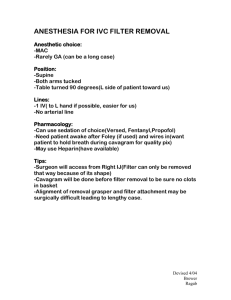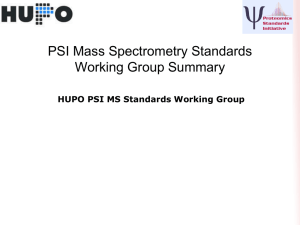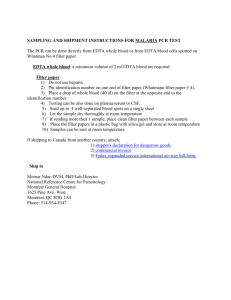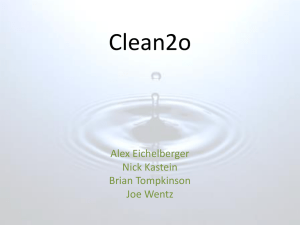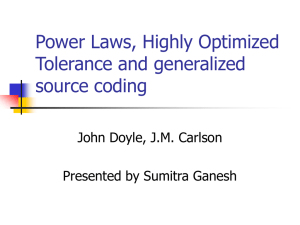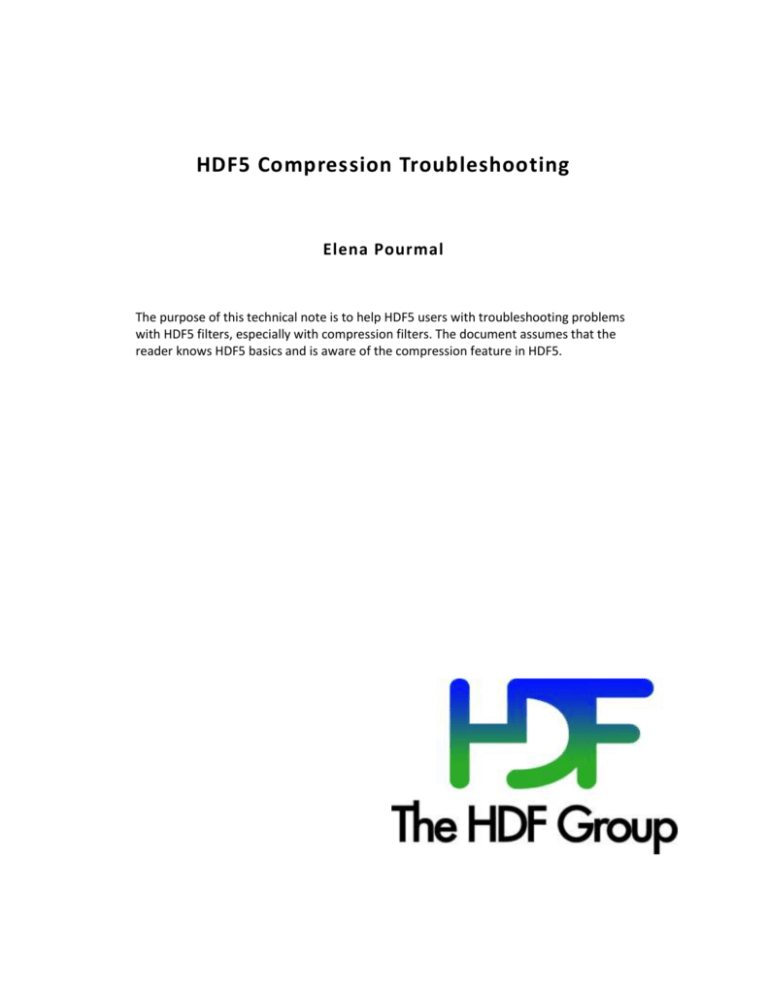
HDF5 Compression Troubleshooting
Elena Pourmal
The purpose of this technical note is to help HDF5 users with troubleshooting problems
with HDF5 filters, especially with compression filters. The document assumes that the
reader knows HDF5 basics and is aware of the compression feature in HDF5.
Copyright 2015 by The HDF Group.
All rights reserved.
For more information about The HDF Group, see www.hdfgroup.org. For more information about
copyrights, see http://www.hdfgroup.org/HDF5/doc/Copyright.html.
Page 2 of 22
HDF5 Compression Troubleshooting
Contents
Contents
1. Introduction .............................................................................................................................................. 4
2. An Overview of HDF5 Compression Troubleshooting .............................................................................. 5
3. If a Filter Was Not Applied ........................................................................................................................ 6
3.1. How the HDF5 Library Configuration May Miss a Compression Filter............................................... 6
3.2. How Does the HDF5 Library Behave in the Absence of a Filter ......................................................... 7
3.3. How to Determine if the HDF5 Library was Configured with a Needed Compression Filter ............. 8
3.3.1. Examine the hdf5lib.settings File ............................................................................................... 9
3.3.2. Examine the H5pubconf.h Header File....................................................................................... 9
3.3.3. Check the HDF5 Library’s Binary .............................................................................................. 10
3.3.4. Check the Compiler Script ........................................................................................................ 11
3.3.5. Using HDF5 APIs ....................................................................................................................... 11
3.4. How to Use HDF5 Tools to Investigate Missing Compression Filters .............................................. 12
3.4.1. How to Use h5dump to Examine Files with Compressed Data ................................................ 12
3.4.2. How to Use h5ls and h5debug to Find a Missing Compression Filter ...................................... 13
3.5. Example Program ............................................................................................................................. 16
4. If a Compression Filter Was Not Effective .............................................................................................. 18
4.1. Compression Comparisons............................................................................................................... 19
4.2. An Alternative to Compression ........................................................................................................ 20
5. Other Resources...................................................................................................................................... 21
6. Revision History ...................................................................................................................................... 22
Page 3 of 22
HDF5 Compression Troubleshooting
Introduction
1. Introduction
One of the most powerful features of HDF5 is the ability to modify, or “filter,” data during I/O1. Filters
provided by the HDF5 Library, “predefined filters,” include several types of data compression2, data
shuffling and checksum. Users can implement their own “user-defined filters” and use them with the
HDF5 Library.
By far the most common user-defined filters are ones that perform data compression. While the
programming model and usage of the compression filters are straightforward, it is easy, especially for
novice users, to overlook important details when implementing compression filters and to end up with
data that is not modified as they would expect.
The purpose of this document is to describe how to diagnose situations where the data in a file is not
compressed as expected.
1
I/O is short for input/output.
In HDF5 documentation including this document, “compression” is often referred to as “compression filter” or
“filter”.
2
Page 4 of 22
HDF5 Compression Troubleshooting
An Overview of HDF5 Compression Troubleshooting
2. An Overview of HDF5 Compression Troubleshooting
Sometimes users may find that HDF5 data was not compressed in a file or that the compression ratio is
very small. By themselves, these results do not mean that compression did not work or did not work
well. These results suggest that something might have gone wrong when a compression filter was
applied. How can users determine the true cause of the problem?
There are two major reasons why a filter did not produce the desired result: it was not applied, or it was
not effective.
The filter was not applied
If a filter was not applied at all, then it was not included at compile time when the library was built or
was not found at run time for dynamically loaded filters.
The absence or presence of HDF5 predefined filters can be confirmed by examining the installed HDF5
files or by using HDF5 API calls. The absence or presence of all filter types can be confirmed by running
HDF5 command-line tools on the produced HDF5 files. See “If a Filter Was Not Applied” on page 6 for
more information.
The filter was applied but was not effective
The effectiveness of compression filters is a complex matter and is only briefly covered this document.
See “If a Compression Filter Was Not Effective” on page 18 for more information. This section gives a
short overview of the problem and provides an example in which the advantages of different
compression filters and their combinations are shown.
Page 5 of 22
HDF5 Compression Troubleshooting
If a Filter Was Not Applied
3. If a Filter Was Not Applied
This section discusses how it may happen that a compression filter is not available to an application and
describes the behavior of the HDF5 Library in the absence of the filter. Then we walk through how to
troubleshoot the problem by checking the HDF5 installation, by examining what an application can do at
run time to see if a filter is available, and by using some HDF5 command line tools to see if a filter was
applied.
Note that in addition to gzip and Szip, there are four other internal predefined filters: shuffle,
fletcher32, scaleoffset, and nbit. These are enabled by default by both configure and
CMake builds. While these filters can be disabled intentionally with the configure flag –disablefilters, disabling them is not recommended. The discussion and the examples in this document
focus on compression filters, but everything said can be applied to other missing internal filters as well.
3.1. How the HDF5 Library Configuration May Miss a Compression Filter
The HDF5 Library uses external libraries for data compression. The two predefined compression
methods are gzip3 and Szip, and these can be requested at the HDF5 Library configuration time
(compile time). User-defined compression filters and the corresponding libraries are usually linked with
an application or provided as a dynamically loaded library.
gzip and Szip require the libz.a(so) and libsz.a(so) libraries, respectively, to be present on the
system and to be enabled during HDF5 configuration with this configure command:
./configure –with-zlib=/path…
–with-szlib=/path… <other flags>
There is one important difference in the behavior of configure between gzip and Szip.
On Unix systems, when GNU Autotools are used to build HDF5, gzip compression is enabled
automatically if the zlib library is present on the system in default locations without explicitly
specifying –with-zlib=/path. For example, if libz.so is installed under /usr/lib with the
header under /usr/include or under /usr/local/lib with the header under
/usr/local/include, the following HDF5 configure command will find the gzip library and will
configure the compression filter in:
./configure
3
gzip compression is called with the H5Pset_deflate function. Deflate compression and gzip compression
refer to the same operation, and we generally use the germ gzip rather than deflate. For more information, see
the “H5P: Property List Interface” page of the HDF5 Reference Manual for the entry for the H5Pset_deflate
function call.
Page 6 of 22
HDF5 Compression Troubleshooting
If a Filter Was Not Applied
The Szip compression should always be requested with the configure flag shown above. configure
will not fail if libraries supporting the requested compression method are not found, for example,
because a specified path was not correct, or the library is missing.
When the library is built with CMake, gzip, and Szip compression filters are enabled by default in the
source code distribution’s config/cmake/cacheinit.cmake file.4 See the CMake installation
instructions for the locations of the libraries.
If compression is not requested or found at configuration time, the compression method is not
registered with the library and cannot be applied when data is written or read. For example, the
h5repack tool will not be able to remove an Szip compression filter from a dataset if the Szip library
was not configured into the library against which the tool was built. The next section discusses the
behavior of the HDF5 Library in the absence of filters.
3.2. How Does the HDF5 Library Behave in the Absence of a Filter
By design, the HDF5 Library allows applications to create and write datasets using filters that are not
available at creation/write time. This feature makes it possible to create HDF5 files on one system and
to write data on another system where the HDF5 Library is configured with or without the requested
filter.
Let’ s recall the HDF5 programming model for enabling filters.
An HDF5 application uses one or more H5Pset_<filter> calls to configure a dataset’s filter pipeline at
its creation time. The excerpt below shows how a gzip filter is added to a pipeline5 with
H5Pset_deflate.
/*
* Create the dataset creation property list, add the gzip
* compression filter and set the chunk size.
*/
dcpl = H5Pcreate (H5P_DATASET_CREATE);
status = H5Pset_deflate (dcpl, 9);
status = H5Pset_chunk (dcpl, 2, chunk);
dset = H5Dcreate (file, DATASET,…, dcpl,…);
For all internal filters (shuffle, fletcher32, scaleoffset, and nbit) and the external gzip
filter, the HDF5 Library does not check to see if the filter is registered when the corresponding
H5Pset_<filter> function is called. The only exception to this rule is H5Pset_szip which will fail if
Szip was not configured in or is configured with a decoder only. Hence, in the example above,
4
Users can overwrite the defaults by using -DHDF5_ENABLE_SZIP_SUPPORT:BOOL=OFF DHDF5_ENABLE_Z_LIB_SUPPORT:BOOL=OFF with the “cmake –C” command. See the INSTALL_CMake.txt file
under the release_docs directory in the HDF5 source distribution.
5
See the complete set of HDF5 examples at The HDF Group website.
Page 7 of 22
HDF5 Compression Troubleshooting
If a Filter Was Not Applied
H5Pset_deflate will succeed. The specified filter will be added to the dataset’s filter pipeline and will
be applied to any data written to this dataset6.
When H5Pset_<filter> is called, a record for the filter is added to the dataset’s object header in the
file, and information about the filter can be queried with the HDF5 APIs and displayed by HDF5 tools
such as h5dump. The presence of filter information in a dataset’s header does not mean that the filter
was actually applied to the dataset’s data, as will be explained later in this document. See “How to Use
HDF5 Tools to Investigate Missing Compression Filters” on page 12 for more information on how to use
h5ls and h5debug to determine if the filter was actually applied.
The success of further write operations to a dataset when filters are missing depends on the filter type.
By design, an HDF5 filter can be optional or required. This filter mode defines the behavior of the HDF5
Library during write operations. In the absence of an optional filter, H5Dwrite calls will succeed and
data will be written to the file, bypassing the filter. A missing required filter will cause H5Dwrite calls to
fail. Clearly, H5Dread calls will fail when filters that are needed to decode the data are missing.
The HDF5 Library has only one required internal filter, Fletcher32 (checksum creation), and one
required external filter, Szip. As mentioned earlier, only the Szip compression (H5Pset_szip) will
flag the absence of the filter. If, despite the missing filter, an application goes on to create a dataset via
H5Dcreate, the call will succeed, but the Szip filter will not be added to the filter pipeline. This
behavior is different from all other filters that may not be present, but will be added to the filter pipeline
and applied during I/O. See the “Using HDF5 APIs” section on page 11 for more information on how to
determine if a filter is available and to avoid writing data while the filter is missing.
Developers who create their own filters should use the “flags” parameter in H5Pset_filter to
declare if the filter is optional or required. The filter type can be determined by calling H5Pget_filter
and checking the value of the “flags” parameter.
For more information on filter behavior in HDF5, see “Filters in HDF5”.
3.3. How to Determine if the HDF5 Library was Configured with a Needed
Compression Filter
The previous section described how the HDF5 Library could be configured without certain compression
filters and the resulting expected library behavior.
The following subsections explain how to determine if a compression method is configured in the HDF5
Library and how to avoid accessing data if the filter is missing.
6
In this document, we talk only about dataset compression. Compression can be also applied to HDF5 groups to
compress the link names stored in local heaps. The behavior of the library when filters are missing is the same for
groups as datasets.
Page 8 of 22
HDF5 Compression Troubleshooting
If a Filter Was Not Applied
3.3.1. Examine the hdf5lib.settings File
To see how the library was configured and built, users should examine the hdf5lib.settings text file
found in the lib directory of the HDF5 installation point and search for the lines that contain the “I/O
filters” string. The hdf5lib.settings file is automatically generated at configuration time when
the HDF5 Library is built with configure on Unix or with CMake on Unix and Windows, and it should
contain the following lines:
I/O filters (external): deflate(zlib),szip(encoder)
I/O filters (internal): shuffle,fletcher32,nbit,scaleoffset
The same lines in the file generated by CMake look slightly different:
I/O filters (external): DEFLATE ENCODE DECODE
I/O filters (internal): SHUFFLE FLETCHER32 NBIT SCALEOFFSET
“ENCODE DECODE” indicates that both the Szip compression encoder and decoder are present. This
inconsistency between configure and CMake generated files will be removed in a future release.
These lines show the compression libraries configured with HDF5. Here is an example of the same
output when external compression filters are absent:
I/O filters (external):
I/O filters (internal): shuffle,fletcher32,nbit,scaleoffset
Depending on the values listed on the I/O filters (external) line, users will be able to tell if their HDF5
files are compressed appropriately. If Szip is not included in the build, data files will not be compressed
with Szip. If gzip is not included in the build and is not installed on the system, then data files will not
be compressed with gzip.
If the hdf5lib.settings file is not present on the system, then users can examine a public header
file or the library binary file to find out if a filter is present, as is discussed in the next two sections.
3.3.2. Examine the H5pubconf.h Header File
To see if a filter is present, users can also inspect the HDF5 public header file7 installed under the
include directory of the HDF5 installation point. If the compression and internal filters are present, the
corresponding symbols will be defined as follows:
/* Define if support for deflate (zlib) filter is enabled */
#define H5_HAVE_FILTER_DEFLATE 1
/* Define if support for Fletcher32 checksum is enabled */
#define H5_HAVE_FILTER_FLETCHER32 1
7
Starting with the HDF5 1.8.15 release, the internals filters will always be present; therefore, the corresponding
defines will not be in the header file.
Page 9 of 22
HDF5 Compression Troubleshooting
If a Filter Was Not Applied
/* Define if support for nbit filter is enabled */
#define H5_HAVE_FILTER_NBIT 1
/* Define if support for scaleoffset filter is enabled */
#define H5_HAVE_FILTER_SCALEOFFSET 1
/* Define if support for shuffle filter is enabled */
#define H5_HAVE_FILTER_SHUFFLE 1
/* Define if support for Szip filter is enabled */
#define H5_HAVE_FILTER_SZIP 1
If a compression or internal filter was not configured, the corresponding lines will be commented out as
follows:
/* Define if support for deflate (zlib) filter is enabled */
/* #undef H5_HAVE_FILTER_DEFLATE */
3.3.3. Check the HDF5 Library’s Binary
The HDF5 Library’s binary contains summary output similar to what is stored in the
hdf5lib.settings file. Users can run the Unix “strings” command to get information about the
configured filters:
% strings libhdf5.a(so) | grep "I/O filters ("
I/O filters (external): deflate(zlib),szip(encoder)
I/O filters (internal): shuffle,fletcher32,nbit,scaleoffset
When compression filters are not configured, the output of the command above will be:
I/O filters (external):
I/O filters (internal): shuffle,fletcher32,nbit,scaleoffset
On Windows one can use the dumpbin /all command, and then view and search the output for
strings like “DEFLATE”, “FLETCHER32”, “DECODE”, and “ENCODE.”
…..
10201860:
10201870:
10201880:
10201890:
102018A0:
102018B0:
102018C0:
102018D0:
4E
69
29
44
20
69
46
42
0A
6C
3A
45
20
6E
4C
49
20
74
20
20
20
74
45
54
20
65
20
45
49
65
20
20
20
72
44
4E
2F
72
46
53
20
73
45
43
4F
6E
4C
43
20
20
46
4F
20
61
45
41
20
28
4C
44
66
6C
54
4C
20
65
41
45
69
29
43
45
20
78
54
0A
6C
3A
48
4F
20
74
45
20
74
20
45
46
49
65
20
20
65
20
52
46
2F
72
44
20
72
53
33
53
4F
6E
45
20
73
48
32
45
20
61
43
20
20
55
20
54
66
6C
4F
20
28
46
4E
0A
N.
I/O f
ilters (external
): DEFLATE DECO
DE ENCODE.
I/O filters (
internal): SHUF
FLE FLETCHER32 N
BIT SCALEOFFSET.
Page 10 of 22
HDF5 Compression Troubleshooting
If a Filter Was Not Applied
3.3.4. Check the Compiler Script
Developers can also use the compiler scripts such as h5cc to verify that a compression library is present
and configured in. Use the “- show” option with any of the compilers scripts found in the bin
subdirectory of the HDF5 installation directory. The presence of –lsz and –lz options among the linker
flags will confirm that Szip or gzip were compiled with the HDF5 Library. See the sample below.
$ h5cc -show
gcc -D_LARGEFILE_SOURCE -D_LARGEFILE64_SOURCE -D_BSD_SOURCE L/mnt/hdf/packages/hdf5/v1812/Linux64_2.6/standard/lib
/mnt/hdf/packages/hdf5/v1812/Linux64_2.6/standard/lib/libhdf5_hl.a
/mnt/hdf/packages/hdf5/v1812/Linux64_2.6/standard/lib/libhdf5.a -lsz -lz -lrt
-ldl -lm -Wl,-rpath -Wl,/mnt/hdf/packages/hdf5/v1812/Linux64_2.6/standard/lib
3.3.5. Using HDF5 APIs
Applications can check filter availability at run time. In order to check the filter’s availability with the
HDF5 Library, users should know the filter identifier (for example, H5Z_FILTER_DEFLATE) and call the
H5Zfilter_avail function as shown in the example below. Use H5Zget_filter_info to determine
if the filter is configured to decode data, to encode data, neither, or both.
/*
* Check if gzip compression is available and can be used for both
* compression and decompression.
*/
avail = H5Zfilter_avail(H5Z_FILTER_DEFLATE);
if (!avail) {
printf ("gzip filter not available.\n");
return 1;
}
status = H5Zget_filter_info (H5Z_FILTER_DEFLATE, &filter_info);
if ( !(filter_info & H5Z_FILTER_CONFIG_ENCODE_ENABLED) ||
!(filter_info & H5Z_FILTER_CONFIG_DECODE_ENABLED) ) {
printf ("gzip filter not available for encoding and decoding.\n");
return 1;
}
H5Zfilter_avail can be used to find filters that are registered with the library or are available via
dynamically loaded libraries. For more information, see “HDF5 Dynamically Loaded Filters.”
Currently there is no HDF5 API call to retrieve a list of all of the registered or dynamically loaded filters.
The default installation directories for HDF5 dynamically loaded filters are
“/usr/local/hdf5/lib/plugin” on Unix and “%ALLUSERSPROFILE%\hdf5\lib\plugin” on
Windows. Users can also check to see if the environment variable HDF5_PLUGIN_PATH is set on the
system and refers to a directory with available plugins.
Page 11 of 22
HDF5 Compression Troubleshooting
If a Filter Was Not Applied
3.4. How to Use HDF5 Tools to Investigate Missing Compression Filters
In this section, we will use the h5dump, h5ls, and h5debug command-line utilities to see if a file was
created with an HDF5 Library that did or did not have a compression filter configured in. For more
information on these tools, see the “HDF5 Tools” page in the HDF5 Reference Manual.
3.4.1. How to Use h5dump to Examine Files with Compressed Data
The h5dump command-line tool can be used to see if a file uses a compression filter. The tool has two
flags that will limit the output: the –p flag causes dataset properties including compression filters to be
displayed, and the –H flag is used to suppress the output of data. The program provided in the “Example
Program” section on page 16 creates a file called h5ex_d_gzip.h5. The output of h5dump shows
that the gzip compression filter set to level 9 was added to the DS1 dataset filter pipeline at creation
time.
$ hdf5/bin/h5dump -p -H *.h5
HDF5 "h5ex_d_gzip.h5" {
GROUP "/" {
DATASET "DS1" {
DATATYPE H5T_STD_I32LE
DATASPACE SIMPLE { ( 32, 64 ) / ( 32, 64 ) }
STORAGE_LAYOUT {
CHUNKED ( 5, 9 )
SIZE 5018 (1.633:1 COMPRESSION)
}
FILTERS {
COMPRESSION DEFLATE { LEVEL 9 }
}
FILLVALUE {
FILL_TIME H5D_FILL_TIME_IFSET
VALUE 0
}
ALLOCATION_TIME {
H5D_ALLOC_TIME_INCR
}
}
}
}
The output also shows a compression ratio defined as (original size)/(storage size). The size of the stored
data is 5018 bytes vs. 8192 bytes of uncompressed data, a ratio of 1.663. This shows that the filter was
successfully applied.
Now let’s look at what happens when the same program is linked against an HDF5 Library that was not
configured with the gzip library.
Notice that some chunks are only partially filled. 56 chunks (7 along the first dimension and 8 along the
second dimension) are required to store the data. Since no compression was applied, each chunk has
Page 12 of 22
HDF5 Compression Troubleshooting
If a Filter Was Not Applied
size 5x9x4 = 180 bytes, resulting in a total storage size of 10,080 bytes. With an original size of 8192
bytes, the compression ratio is 0.813 (in other words, less than 1) and visible in the output below.
$ hdf5/bin/h5dump -p -H *.h5
HDF5 "h5ex_d_gzip.h5" {
GROUP "/" {
DATASET "DS1" {
DATATYPE H5T_STD_I32LE
DATASPACE SIMPLE { ( 32, 64 ) / ( 32, 64 ) }
STORAGE_LAYOUT {
CHUNKED ( 5, 9 )
SIZE 10080 (0.813:1 COMPRESSION)
}
FILTERS {
COMPRESSION DEFLATE { LEVEL 9 }
}
FILLVALUE {
FILL_TIME H5D_FILL_TIME_IFSET
VALUE 0
}
ALLOCATION_TIME {
H5D_ALLOC_TIME_INCR
}
}
}
}
As discussed in the “How Does the HDF Library Behave in the Absence of a Filter” section on page 7, the
presence of a filter in an object’s filter pipeline does not imply that it will be applied unconditionally
when data is written.
If the compression ratio is less than 1, compression is not applied. If it is 1, and compression is shown by
h5dump, more investigation is needed; this will be discussed in the next section.
3.4.2. How to Use h5ls and h5debug to Find a Missing Compression Filter
Filters operate on chunked datasets. A filter may be ineffective for one chunk (for example, the
compressed data is bigger than the original data), and succeed on another. How can users discern if a
filter is missing or just ineffective (and as a result non-compressed data was written)? The h5ls and
h5debug command-line tools can be used to investigate the issue.
First, let’s take a look at what kind of information h5ls displays about the dataset DS1 in our example
file, which was written with an HDF5 library that has the deflate filter configured in:
$ h5ls -vr h5ex_d_gzip.h5
Opened "h5ex_d_gzip.h5" with sec2 driver.
/
Group
Location: 1:96
Links:
1
/DS1
Dataset {32/32, 64/64}
Page 13 of 22
HDF5 Compression Troubleshooting
Location:
Links:
Chunks:
Storage:
Filter-0:
Type:
If a Filter Was Not Applied
1:800
1
{5, 9} 180 bytes
8192 logical bytes, 5018 allocated bytes, 163.25% utilization
deflate-1 OPT {9}
native int
We see output similar to h5dump output with the compression ratio at 163%.
Now let’s compare this output with another dataset DS1, but this time the dataset was written with a
program linked against an HDF5 library without the gzip filter present.
$ h5ls -vr h5ex_d_gzip.h5
Opened "h5ex_d_gzip.h5" with sec2 driver.
/
Group
Location: 1:96
Links:
1
/DS1
Dataset {32/32, 64/64}
Location: 1:800
Links:
1
Chunks:
{5, 9} 180 bytes
Storage:
8192 logical bytes, 10080 allocated bytes, 81.27% utilization
Filter-0: deflate-1 OPT {9}
Type:
native int
The h5ls output above shows that the gzip filter was added to the filter pipeline of the dataset DS1. It
also shows that the compression ratio is less than 1. We can confirm by using h5debug that the filter
was not applied at all, and, as a result of the missing filter, the individual chunks were not compressed.
From the h5ls output we know that the dataset object header is located at address 800. We retrieve
the dataset object header at address 800 and search the layout message for the address of the chunk
index B-tree as shown in the excerpt of the h5debug output below:
$ h5debug h5ex_d_gzip.h5 800
Reading signature at address 800 (rel)
Object Header...
…..
Message 4...
Message ID (sequence number):
Dirty:
Message flags:
Chunk number:
Raw message data (offset, size) in chunk:
Message Information:
Version:
Type:
Number of dimensions:
Size:
Index Type:
B-tree address:
0x0008 `layout' (0)
FALSE
<C>
0
(144, 24) bytes
3
Chunked
3
{5, 9, 4}
v1 B-tree
1400
Now we can retrieve the B-tree information:
Page 14 of 22
HDF5 Compression Troubleshooting
$ h5debug h5ex_d_gzip.h5 1400 3 8
Reading signature at address 1400 (rel)
Tree type ID:
Size of node:
Size of raw (disk) key:
Dirty flag:
Level:
Address of left sibling:
Address of right sibling:
Number of children (max):
Child 0...
Address:
Left Key:
Chunk size:
Filter mask:
Logical offset:
Right Key:
Chunk size:
Filter mask:
Logical offset:
Child 1...
Address:
Left Key:
Chunk size:
If a Filter Was Not Applied
H5B_CHUNK_ID
2616
32
False
0
UNDEF
UNDEF
56 (64)
4016
180 bytes
0x00000001
{0, 0, 0}
180 bytes
0x00000001
{0, 9, 0}
4196
180 bytes
We see that the size of each chunk is 180 bytes: in other words, compression was not successful. The
filter mask value 0x00000001 indicates that filter was not applied. For more information on the filter
mask, see the “Version 1 B-trees (B-link trees)” section in the HDF5 File Format Specification.
8
Users have to supply the chunk rank. According to the HDF5 File Format Specification, this is the dataset rank plus
1; in other words, 3.
Page 15 of 22
HDF5 Compression Troubleshooting
If a Filter Was Not Applied
3.5. Example Program
The example program used to create the file discussed in this document is a modified version of the
program available at http://www.hdfgroup.org/ftp/HDF5/examples/examples-by-api/hdf5examples/1_8/C/H5D/h5ex_d_gzip.c. It was modified to have chunk dimensions not be factors of the
dataset dimensions. Chunk dimensions were chosen for demonstration purposes only and are not
recommended for real applications.
#include <stdlib.h>
#define
#define
#define
#define
#define
#define
FILE
DATASET
DIM0
DIM1
CHUNK0
CHUNK1
int
main (void)
{
hid_t
herr_t
htri_t
H5Z_filter_t
hsize_t
size_t
unsigned int
int
"h5ex_d_gzip.h5"
"DS1"
32
64
5
9
file, space, dset, dcpl;
/* Handles */
status;
avail;
filter_type;
dims[2] = {DIM0, DIM1},
chunk[2] = {CHUNK0, CHUNK1};
nelmts;
flags,
filter_info;
wdata[DIM0][DIM1],
/* Write buffer */
rdata[DIM0][DIM1],
/* Read buffer */
max,
i, j;
/*
* Initialize data.
*/
for (i=0; i<DIM0; i++)
for (j=0; j<DIM1; j++)
wdata[i][j] = i * j - j;
/*
* Create a new file using the default properties.
*/
file = H5Fcreate (FILE, H5F_ACC_TRUNC, H5P_DEFAULT, H5P_DEFAULT);
/*
* Create dataspace. Setting maximum size to NULL sets the maximum
* size to be the current size.
*/
space = H5Screate_simple (2, dims, NULL);
/*
* Create the dataset creation property list, add the gzip
* compression filter and set the chunk size.
Page 16 of 22
HDF5 Compression Troubleshooting
If a Filter Was Not Applied
*/
dcpl = H5Pcreate (H5P_DATASET_CREATE);
status = H5Pset_deflate (dcpl, 9);
status = H5Pset_chunk (dcpl, 2, chunk);
/*
* Create the dataset.
*/
dset = H5Dcreate (file, DATASET, H5T_STD_I32LE, space, H5P_DEFAULT, dcpl,
H5P_DEFAULT);
/*
* Write the data to the dataset.
*/
status = H5Dwrite (dset, H5T_NATIVE_INT, H5S_ALL, H5S_ALL, H5P_DEFAULT,
wdata[0]);
/*
* Close
*/
status =
status =
status =
status =
and release resources.
H5Pclose
H5Dclose
H5Sclose
H5Fclose
(dcpl);
(dset);
(space);
(file);
return 0;
}
Page 17 of 22
HDF5 Compression Troubleshooting
If a Compression Filter Was Not Effective
4. If a Compression Filter Was Not Effective
There is no “one size fits all” compression filter solution. Users have to consider a number of
characteristics such as the type of data, the desired compression ratio, the encoding/decoding speed,
the general availability of a compression filter, and licensing among other issues before committing to a
compression filter. This is especially true for data producers. The way data is written will affect how
much bandwidth consumers will need to download data products, how much system memory and time
will be required to read the data, and how many data products can be stored on the users’ system to
name a few issues. Users should plan on experimenting with various compression filters and settings.
The following are some suggestions for where to start finding the best compression filter for your data:
1. Find the compression filter which operates best on the type of data in the file and for the
objectives of the file users. Different applications, data providers, and data consumers will work
differently with different compression filters. For example, Szip compression is fast but
typically achieves smaller compression ratios for floating point data than gzip. For more
information on Szip, see the “Szip Compression in HDF Products” page.
2. Once you have the right compression method, find the right parameters. For example, gzip
compression at level 6 usually achieves a compression ratio comparable to level 9 in less time.
For more information on compression levels, see the H5Pset_deflate entry on the “H5P:
Property List Interface” page of the HDF5 Reference Manual.
3. Data preprocessing using a filter such as shuffling in combination with compression can
drastically improve the compression ratio. See the “Compression Comparisons” section below
for more information.
The h5repack tool can be used to experiment with the data to address the items above.
Users should also look beyond compression. An HDF5 file may contain a substantial amount of unused
space. The h5stat tool can be used to determine if space is used efficiently in an HDF5 file, and the
h5repack tool can be used to reduce the amount of unused space in an HDF5 file. See “An Alternative
to Compression” on page 20 for more information.
Page 18 of 22
HDF5 Compression Troubleshooting
If a Compression Filter Was Not Effective
4.1. Compression Comparisons
An extensive comparison of different compression filters is outside the scope of this document.
However, it is easy to show that, unless a suitable compression method or an advantageous filter
combination is chosen, applying the same compression filter to different types of data may not reduce
HDF5 file size as much as possible.
For example, we looked at a NASA weather data product file packaged with it its geolocation
information (the file name is GCRIOREDRO_npp_d20030125_t0702533_e0711257_b00993_c20140501163427060570_XXXX_XXX.h
5) and used h5repack to apply three different compressions to the original file:
1. gzip with compression level 7
2. Szip compression using NN mode and 32-bit block size
3. Shuffle in combination with gzip compression level 7
Then we compared the sizes of the 32-bit floating dataset /All_Data/CrIMSS-EDR-GEOTC_All/Height when different types of compression were used and compared for the sizes of the 32bit integer dataset /All_Data/CrIMSS-EDR_All/FORnum. The results are shown in the table below.
Data
Original
gzip Level 7
Szip Using NN
32-bit Floats
1
2.087
Mode and Blocksize 32
1.628
32-bit Integers
1
3.642
10.832
Shuffle and
gzip Level 7
2.56
38.20
Table 1: Compression ratio for different types of compressions when using h5repack
The combination of the shuffle filter and gzip compression level 7 worked well on both floating point
and integer datasets, as shown in the fifth column of the table above. gzip compression worked better
than Szip on the floating point dataset, but not on the integer dataset as shown by the results in
columns three and four. Clearly, if the objective is to minimize the size of the file, datasets with different
types of data have to be compressed with different compression methods.
For more information on the shuffle filter, see the “Data Pipeline Filters” section (5.4.2) in the “HDF5
Datasets” chapter of the HDF5 User’s Guide. See also the “H5P: Property List Interface” page of the
HDF5 Reference Manual for the H5Pset_shuffle function call entry.
Page 19 of 22
HDF5 Compression Troubleshooting
If a Compression Filter Was Not Effective
4.2. An Alternative to Compression
Sometimes HDF5 files contain unused space. The h5repack command-line tool can be used to reduce
the amount of unused space in a file without changing any storage parameters of the data. For example,
running h5stat on the file GCRIOREDRO_npp_d20030125_t0702533_e0711257_b00993_c20140501163524579819_XXXX_XXX.h
5 shows:
Summary of file space information:
File metadata: 425632 bytes
Raw data: 328202 bytes
Unaccounted space: 449322 bytes
Total space: 1203156 bytes
After running h5repack, the file shows a 10-fold reduction in unaccounted space:
Summary of file space information:
File metadata: 425176 bytes
Raw data: 328202 bytes
Unaccounted space: 45846 bytes
Total space: 799224 bytes
There is also a small reduction in file metadata space.
For more information on h5repack and h5stat, see the “HDF5 Tools” page in the HDF5 Reference
Manual.
Page 20 of 22
HDF5 Compression Troubleshooting
Other Resources
5. Other Resources
See the following documents published by The HDF Group for more information.
See the “Creating a Compressed Dataset” tutorial on The HDF Group website.
The “Filter Behavior in HDF5” sub-section is part of the H5Pset_filter function call entry. See
the “H5P: Property List Interface” page of the HDF5 Reference Manual.
Page 21 of 22
HDF5 Compression Troubleshooting
Revision History
6. Revision History
April 24, 2015:
Initial published version.
Page 22 of 22

